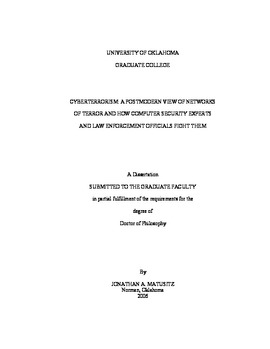| dc.contributor.advisor | Kramer, Eric M., | en_US |
| dc.contributor.author | Matusitz, Jonathan A. | en_US |
| dc.date.accessioned | 2013-08-16T12:20:04Z | |
| dc.date.available | 2013-08-16T12:20:04Z | |
| dc.date.issued | 2006 | en_US |
| dc.identifier.uri | https://hdl.handle.net/11244/1000 | |
| dc.description.abstract | The purpose of this study is to investigate how cyberterrorists create networks in order to engage in malicious activities against the Internet and computers. The purpose of the study is also to understand how computer security labs (i.e., in universities) and various agencies (that is, law enforcement agencies such as police departments and the FBI) create joint networks in their fight against cyberterrorists. This idea of analyzing the social networks of two opposing sides rests on the premise that it takes networks to fight networks. The ultimate goal is to show that, because of the postmodern nature of the Internet, the fight between networks of cyberterrorists and networks of computer security experts (and law enforcement officials) is a postmodern fight. Two theories are used in this study: social network theory and game theory. | en_US |
| dc.description.abstract | This study employed qualitative methodology and data were collected via in-depth conversational (face-to-face) interviewing. Twenty-seven computer security experts and law enforcement officials were interviewed. Overall, this study found that cyberterrorists tend not to work alone. Rather, they team up with others through social networks. It was also found that it takes networks to fight networks. As such, it is necessary for experts and officials to combine efforts, through networking, in order to combat, let alone understand, cyberterrorist networks. Of equal relevance is the fact that law enforcement agents and computer security experts do not always engage in battle with cyberterrorists. They sometimes try to interact with them in order to obtain more information about their networks (and vice versa). Finally, four themes were identified from the participants' accounts: (1) postmodern state of chaos, (2) social engineering, (3) know thy enemy, and (4) the enemy of my enemy is my friend. | en_US |
| dc.format.extent | x, 483 leaves : | en_US |
| dc.subject | Cyberterrorism. | en_US |
| dc.subject | Computer hackers Social conditions. | en_US |
| dc.subject | Cyberterrorism Prevention. | en_US |
| dc.subject | Terrorists Social conditions. | en_US |
| dc.subject | Mass Communications. | en_US |
| dc.subject | Political Science, International Law and Relations. | en_US |
| dc.subject | Sociology, Criminology and Penology. | en_US |
| dc.title | Cyberterrorism: A postmodern view of networks of terror and how computer security experts and law enforcement officials fight them. | en_US |
| dc.type | Thesis | en_US |
| dc.thesis.degree | Ph.D. | en_US |
| dc.thesis.degreeDiscipline | Department of Communication | en_US |
| dc.note | Adviser: Eric M. Kramer. | en_US |
| dc.note | Source: Dissertation Abstracts International, Volume: 67-02, Section: A, page: 0383. | en_US |
| ou.identifier | (UMI)AAI3207541 | en_US |
| ou.group | College of Arts and Sciences::Department of Communication | |
